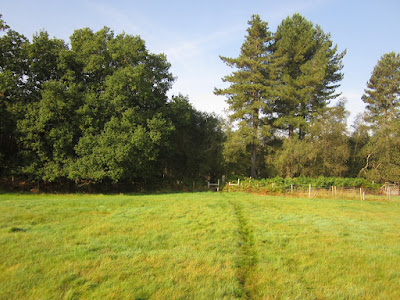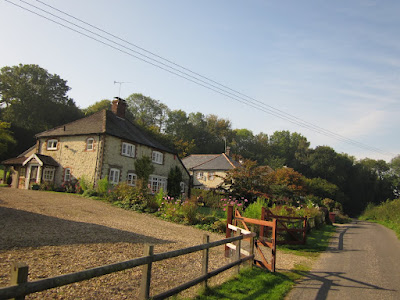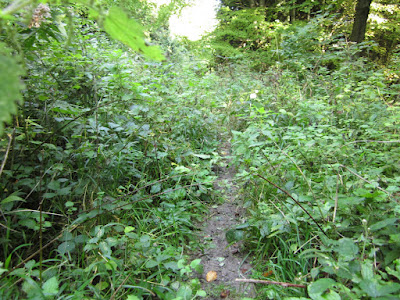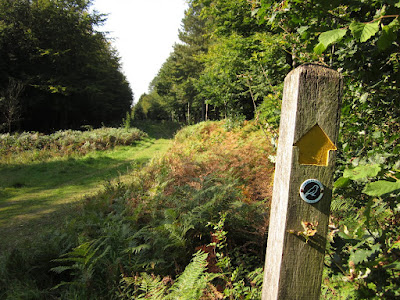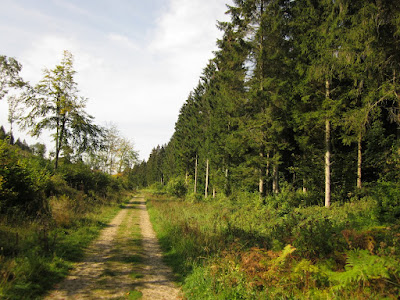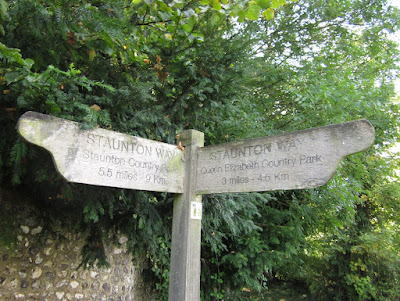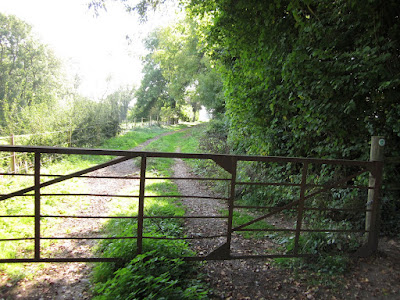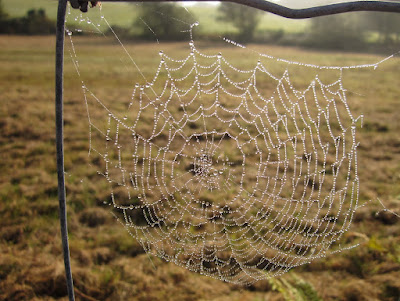I was quite excited to be walking my final SBP leg today, and was very pleased that the weather forecast was so good. I had read that Thorney Island is quite exposed and it would certainly help if there was some nice sunshine around.
 |
| The route |
As for the previous section, I got up very early and drove west to Emsworth, parking up pretty much right on the SBP. Unusually, I would pass my car part way through the walk today as I was walking an ‘upside down lollypop’ shape – a linear walk from Rowlands Castle to Emsworth and then a circuit of Thorney Island. My plan had been to walk to the hospital and catch the 8am bus to Rowlands Castle. Unfortunately, the bus did not arrive, and when I phoned the bus company I was told that they had changed the timetable the previous weekend and the first bus was now at 9am on Saturdays! Luckily I was also near the train station and, although it involved changing at Havant, managed to do the transfer pretty easily, and eventually arrived in Rowlands Castle at 8.45am.
 |
| The start of today's route from Finchdean Road |
From Finchdean Road, I took a footpath running roughly eastwards along the edge of Stansted Forest. Apart from a small climb on a curving path near the start, the route was flat and straight as a die – a wide grassy avenue between trees. I believe this must relate in some way to Stansted House which I think was just visible in the distance.
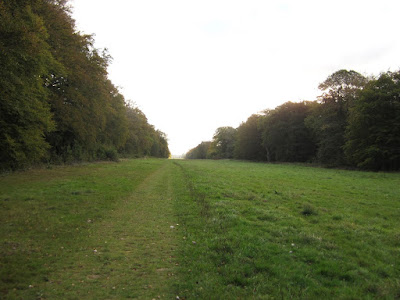 |
| The Avenue, leading to Stansted House, just visible in the distance |
About 1km from the start I left The Avenue, turning right (S) to descend very gently across a field towards Horsepasture Farm. At the farm drive I turned left along the edge of Lyeis Wood before arriving at Holme Farm. The path here went right through the farm buildings close to some stables. I would certainly be concerned about that if I kept a horse here.
 |
| Strawbales alongside Lyeis Wood |
Turning SW on a private road, I passed a few properties, and exchanged pleasantries with someone riding a nice horse. The road ended at the edge of a wood, where it became a bridleway, climbing gently up to cross Woodberry Lane. The bridleway continued through woodland in the wonderfully named Shuffles Plantation – the mature conifer trees looked lovely with the early morning sun slanting through them.
 |
| Shuffles Plantation |
After about 500m I reached the busy Emsworth Common Road where I turned right and walked along the verge for about 300m before reaching another bridleway into Hollybank Nature Reserve. As I was walking along the road, and dodging the traffic, I realised there was also a permissive path marked on the map in the woods which I could have taken to avoid the road, and having checked the online SBP now, they do indeed suggest you take that route. However, my map showed the SBP going along the road, so that is what I did.
 |
| Taking my life in my hands (unnecessarily as it turned out) on Emsworth Common Road |
Hollybank Wood is part of the Forest of Bere, a remnant of an ancient Norman royal hunting forest. When I reached the junction with the aforementioned permissive path, a group of cyclists burst at high speed onto my path, but turned away from me down the route I would be taking.
 |
| Entering Hollybank Wood |
After emerging from the wood, the route joined a road along the edge of a residential area. I’m not entirely sure if this was part of Westbourne, or Emsworth, as it is not attached directly to either. Skirting the edge of the houses, initially on a pavement and then on a unmetalled track, I arrived at a roundabout and turned left on the B2147. This too was along the edge of the residential area and there were fields to the left. It was clearly a horsey area, and two ponies were causing something of a traffic holdup as they were being led along the road.
 |
| Ponies being led along the B2147 |
Shortly before reaching Westbourne church I turned right off the road. Initially the path was narrow, but it soon opened out into a large field where cattle were grazing. Keeping close to the back of the houses, I could now clearly hear the noisy traffic on the A27 ahead of me. Reaching the end of the field, I walked through a large tunnel under the major trunk road and then continued towards a railway bridge. However, rather than walk under the bridge, my route turned away and took me to the hamlet of Lumley, where there was a very attractive white house and mill stream.
 |
| Lumley Mill |
Now the route turned south again and this time did pass under the railway, following a pleasant residential road in the Emsworth suburb of Hermitage, where the properties needed little bridges to reach their front doors as a stream ran between them and the road.
 |
| Cottages in Lumley |
This road ended at the A259 close to where I had parked my car that morning. As there was an attractive pond and a handy bench here I stopped for a coffee break. I then took the opportunity of ditching my flask and fleece in the car, taking my sleeveless gillet instead. Although I couldn’t yet see it, I could definitely smell the sea now.
 |
| Pond near Emsworth, close to my parking spot |
Setting off again, I crossed the road and admired the Slipper Pond before heading east along the road to the Sussex Brewery pub, where a footpath went down a the side of the pub to a field where piebald gypsy ponies were tethered out. I followed the edge of this field to Emsworth Yacht Harbour, walking past numerous boats out of the water and past some unusual deckhouses on stilts.
 |
| Emsworth yacht harbour |
Reaching a waymarker, the footpath turned away from the marina area to head east again to cross another lane, before heading up a narrow overgrown path between hedges into a another large field. This led to Thornham Farm, where I joined the access drive for a few hundred meters to reach a parking area at the edge of Chichester Harbour, and the start of the seven mile circumnavigation of Thorney Island. Jutting out into Chichester harbour, the Island was used as an RAF station until 1976, and has therefore remained remote and free from commercial development.
 |
| Info Board |
The tide was well out and the view across the marshes and mudflats was gorgeous, particularly as the sun was shining and reflecting off the wet surface. There was quite a chilly breeze blowing however and I was glad I had kept my fleece jerkin on when discarding my jacket back at the car.
 |
| Nutbourne Marshes |
The route headed first round a small bay and passed a marina area on a narrow gangway bridge and then a more substantial footbridge to reach Prinsted Point, and on to Thornham Point. Before Thorney Island became attached to the mainland by land reclamation in the 1870s, this area was on a small peninsula ending with Thornham Point at its tip.
 |
| Prinsted Point |
There then followed a very straight path on top of the sea wall, which eventually veered round Stanbury Point after a little over one kilometer. Part way along this straight section I had to pass through a security gate because the southern part of the island is still owned by the MOD. It was necessary to press an intercom button and then some unseen guard, who was presumably watching me on the security camera, opened the gate and let me through. Seemed a bit daft really!
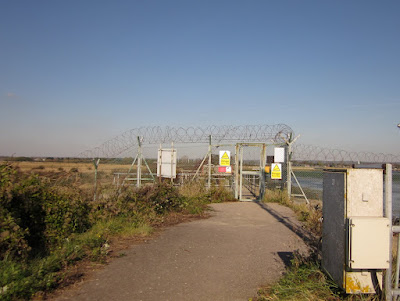 |
| Looking back at the security gate |
When I reached a slipway near a marina area I briefly left the shoreline path, first to see the delightful St Nicholas Church at West Thorney, and then to avoid the Thorney Island Sailing Club premises. As I reached the seawall again, there was a curious waymarker pointing directly east out into the channel. This is not marked on the map and I cannot believe you can cross over at any time of day, whatever the tide is doing!
 |
| Surely this waymarker is pointing the wrong way? |
For a while the path was away from the sea wall, a little inland, first on an open grassy area close to the old RAF runways and then on a narrow path lined by hedges. There had been a cloudless sky for much of the day so far, but clouds were beginning to bubble up a little now.
 |
| Enclosed path |
At the end of the bushes, I passed a bird-watching hide and soon reached the most southerly tip of the island, called Longmere Point where there was a narrow sandy beach. It was tempting to stop here for a break but there were no benches, so I pressed on a bit further.
 |
| The beach at Longmere Point |
The path soon became a gravel track and after a while became rather enclosed again. Here I spotted a number of people walking ahead of me, and I caught them up at a lovely spot where there were two large remembrance benches for soldiers lost in Afghanistan. The group of four (plus two Golden Retrievers) took one bench and I took the other, where there was actually a Book of Remembrance enclosed in a metal container, which people could sign if they wanted.
 |
| At the memorial bench, Longmere Point |
I got one of the ladies to take my photo on the bench before they set off again. I lingered for about 15 minutes, just time for a snack and a quick read of my Kindle (Jurassic Park), before setting off on the grassy path to Marker Point with fine views across the Emsworth Channel to Hayling Island.
 |
| Looking across Emsworth Channel towards Hayling Island |
Keeping close to the shore line, the path curved round three bays with pasture land on the landward side. After passing through a kissing gate at the end of the pastures I arrived at an MOD security gate again where fortunately I was let out!
 |
| The first of three bays between Marker Point and the exit from the MOD area at Wickor Point |
The path now followed a straight causeway on a high bank, passing Deep Channel en route – a wide tract of inland water which makes Thorney a real island. Ahead I could see yachts and riverside houses at Emsworth. I caught up with the Golden Retriever people on this section, although they were walking on a sheltered path on the landward side of the causeway. They were walking rather slowly and one of the women seemed to be limping.
 |
| Deep Channel |
Soon I arrived back at the stilted deckhouses, passing by on the opposite side of them, and then turned right through the Yacht Harbour and past two marina basins to reach my outward path. This time however, I turned left out of the gypsy pony field to reach the Slipper Mill. Continuing on a causeway adjacent to the Slipper Mill Pond, I passed a sluice gate which controls the pond level when the tide is out.
 |
| Looking back along the causeway besides the mill pond |
Turning right round the edge of the pond I followed another causeway (which apparently is on the exact county boundary between West Sussex and Hampshire) to the road by the Lord Raglan pub. I retired to their garden for a swift half of lime & soda in very modest celebration of my completion of the Sussex Border Path. As I returned to my car I spotted a man feeding the ducks with his young son, and he kindly took my photo next to a convenient SBP waymarker near the pond.
 |
| Mission accomplished! |
Well, that is another long distance path completed and a very fine one it is too. It has taken a while to do, as I started with my friend Anne back in March 2009. We completed most of the eastern section from East Grinstead to Bodiam Castle that year, and also started the Mid Sussex Link. In 2010 we only managed to walk three sections, completing both the Mid Sussex Link and the Eastern Section to Rye.
Although I am no longer able to walk with Anne, I was determined to walk the western section alone this year and I feel a sense of achievement at having done so. Some of the earlier sections ended up being rather short, either due to hot weather (if I had the dogs with me), or the necessity of doing circular walks due to the lack of public transport, but it is now complete. Where next?










